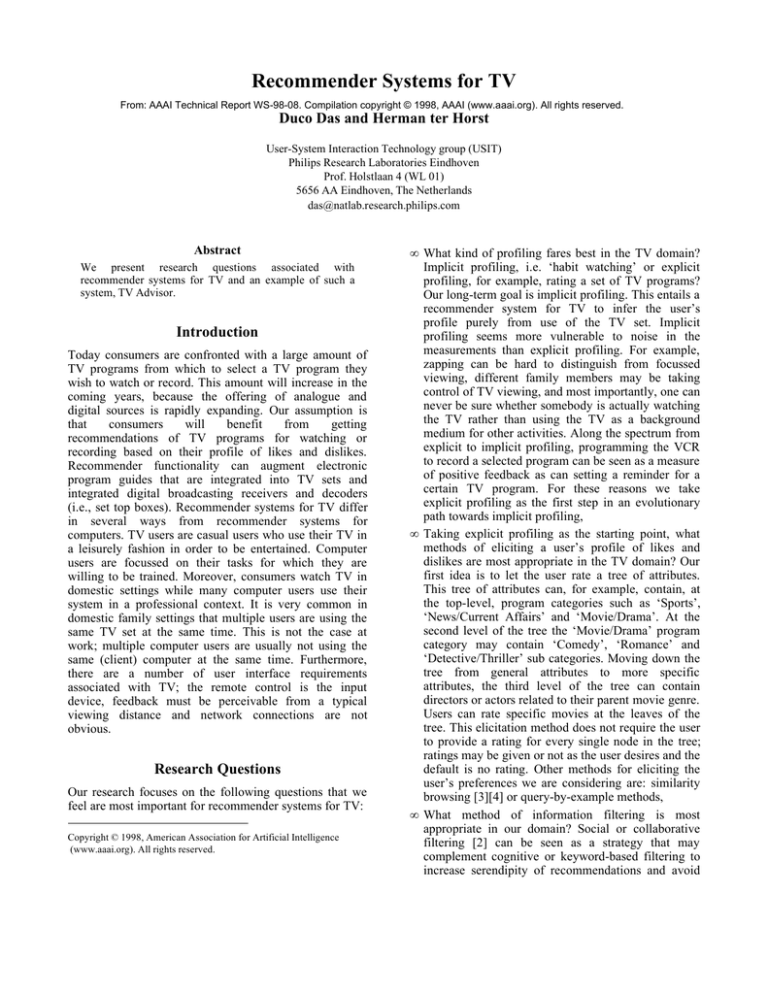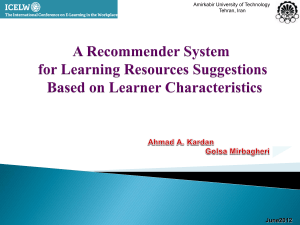
Recommender Systems for TV
From: AAAI Technical Report WS-98-08. Compilation copyright © 1998, AAAI (www.aaai.org). All rights reserved.
Duco Das and Herman ter Horst
User-System Interaction Technology group (USIT)
Philips Research Laboratories Eindhoven
Prof. Holstlaan 4 (WL 01)
5656 AA Eindhoven, The Netherlands
das@natlab.research.philips.com
Abstract
We present research questions associated with
recommender systems for TV and an example of such a
system, TV Advisor.
Introduction
Today consumers are confronted with a large amount of
TV programs from which to select a TV program they
wish to watch or record. This amount will increase in the
coming years, because the offering of analogue and
digital sources is rapidly expanding. Our assumption is
that
consumers
will
benefit
from
getting
recommendations of TV programs for watching or
recording based on their profile of likes and dislikes.
Recommender functionality can augment electronic
program guides that are integrated into TV sets and
integrated digital broadcasting receivers and decoders
(i.e., set top boxes). Recommender systems for TV differ
in several ways from recommender systems for
computers. TV users are casual users who use their TV in
a leisurely fashion in order to be entertained. Computer
users are focussed on their tasks for which they are
willing to be trained. Moreover, consumers watch TV in
domestic settings while many computer users use their
system in a professional context. It is very common in
domestic family settings that multiple users are using the
same TV set at the same time. This is not the case at
work; multiple computer users are usually not using the
same (client) computer at the same time. Furthermore,
there are a number of user interface requirements
associated with TV; the remote control is the input
device, feedback must be perceivable from a typical
viewing distance and network connections are not
obvious.
Research Questions
Our research focuses on the following questions that we
feel are most important for recommender systems for TV:
Copyright © 1998, American Association for Artificial Intelligence
(www.aaai.org). All rights reserved.
• What kind of profiling fares best in the TV domain?
Implicit profiling, i.e. ‘habit watching’ or explicit
profiling, for example, rating a set of TV programs?
Our long-term goal is implicit profiling. This entails a
recommender system for TV to infer the user’s
profile purely from use of the TV set. Implicit
profiling seems more vulnerable to noise in the
measurements than explicit profiling. For example,
zapping can be hard to distinguish from focussed
viewing, different family members may be taking
control of TV viewing, and most importantly, one can
never be sure whether somebody is actually watching
the TV rather than using the TV as a background
medium for other activities. Along the spectrum from
explicit to implicit profiling, programming the VCR
to record a selected program can be seen as a measure
of positive feedback as can setting a reminder for a
certain TV program. For these reasons we take
explicit profiling as the first step in an evolutionary
path towards implicit profiling,
• Taking explicit profiling as the starting point, what
methods of eliciting a user’s profile of likes and
dislikes are most appropriate in the TV domain? Our
first idea is to let the user rate a tree of attributes.
This tree of attributes can, for example, contain, at
the top-level, program categories such as ‘Sports’,
‘News/Current Affairs’ and ‘Movie/Drama’. At the
second level of the tree the ‘Movie/Drama’ program
category may contain ‘Comedy’, ‘Romance’ and
‘Detective/Thriller’ sub categories. Moving down the
tree from general attributes to more specific
attributes, the third level of the tree can contain
directors or actors related to their parent movie genre.
Users can rate specific movies at the leaves of the
tree. This elicitation method does not require the user
to provide a rating for every single node in the tree;
ratings may be given or not as the user desires and the
default is no rating. Other methods for eliciting the
user’s preferences we are considering are: similarity
browsing [3][4] or query-by-example methods,
• What method of information filtering is most
appropriate in our domain? Social or collaborative
filtering [2] can be seen as a strategy that may
complement cognitive or keyword-based filtering to
increase serendipity of recommendations and avoid
user profile circumscription (i.e., local optimization).
Moreover, cognitive filtering suffers less from the
problem of critical mass than social filtering; for
social filtering to take effect many user profiles are
needed to achieve high levels of correlation. Finally,
in our TV domain network connections that are
needed to access user profiles from other users are
not obvious. Even if these network connections are
available, for example, with the WebTV set top box,
they are not available all the time. In the consumer
domain, temporary unavailability of a feature due to
network problems is unacceptable. For these reasons,
we are initially focussing on cognitive filtering
methods for a recommender system for TV.
Other research questions that need to be addressed are:
• How to provide non-obtrusive identification for
different household members, if we take explicit
profiling as the starting point?,
• How to generate group recommendations? While we
take group recommendations into account in a
conceptual information model, our initial focus will
be on recommendation for one person,
• What method of user profile editing is most
appropriate for our domain? For example, user’s
preferences change over time and they may make
errors in providing the system with their preferences.
TV Advisor: a Recommender System for TV
We have designed and implemented a recommender
research prototype system for TV, called ‘TV Advisor’.
TV Advisor recommends TV programs for watching or
recording, based on a user’s profile of likes and dislikes.
The TV Advisor system is composed of two sub systems:
1. A TV program information gathering sub system.
This sub system accesses a Dutch web site that
contains the program schedules of 39 European
broadcasters over a period of several weeks. After an
HTML page has been saved, it is parsed and input
files for a database and full text-retrieval engine are
generated. The database is filled with TV program
records that contain program title, broadcaster, start
date and time, end date and time and (optionally) a
program summary. For the full-text retrieval engine
the program title and summaries are indexed,
2. A TV program recommender system. This sub system
is a web server that provides a user with a set of
recommendations using HTML form submission and
CGI bin scripts. Users can enter their likes and
dislikes by rating a set of 10 TV program subject
categories on a 7 point Likert scale. The 10 TV
program subject categories are the 10 top-level
program categories defined in the European Digital
Video Broadcasting Service Information (DVB-SI)
[1] standard. They include ‘Sports’, ‘News/Current
Affairs’ and ‘Movie/Drama’. Users may also specify
their preferences at a finer granularity as mentioned
earlier. To generate recommendations, full-retrieval
queries are initiated on the index generated in (1).
These queries contain nodes in the program category
tree that have been rated by the user. The program
information of the top n (where n is a number
specified by the user) ‘hits’ is retrieved from the
database. Finally, the resulting set of recommended
TV programs is ordered on starting time and date,
omitting TV programs that have ended. This list of
recommendations includes among the information in
the database also a number of stars that express the
confidence the system has in the recommendation.
Conclusions
While this is only the first iteration of several cycles of
design, implementation and user evaluation the ‘TV
Advisor’ system will undergo, some first observations can
be made:
• Cognitive filtering using a tree of user likes and
dislikes and a rich set of program information seems
a sufficient method for generating sensible
recommendations of TV programs. ‘TV Advisor’ can
make some relevant and potentially interesting
recommendations,
• Omission of a single relevant TV program is not
acceptable for consumers. Hence, recall should be
favored at the cost of precision,
• The set of suggested TV programs must never be
empty. If there are no matches between the user's
profile and the current offering of TV programs, the
system must still provide the user with some sensible
recommendations.
References
1. Specification for Service Information (SI) in Digital
Video Broadcasting (DVB) Systems, Final Draft ETS
300
468,
23
January
1996,
European
Telecommunication Standard.
2. Malone, T.W., Grant, K.R., Turbak, F.A., Brobst,
S.A., and Cohen, M.D., Intelligent Information
Sharing Systems, CACM May 1987 Volume 30
Number 5, pp. 390-402.
3. Strubbe, H.J., System and Method for Automatically
Correlating User Preferences with a T.V. Program
Information Database, U.S. Patent 5,233,924.
4. Strubbe, H.J., et al., System and Method for Finding a
Movie of Interest in a Large Movie Database, U.S.
Patent 5,483,278.


